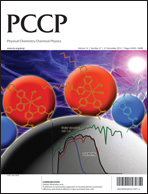Theoretical study of the Si5−n(BH)n2− and Na(Si5−n(BH)n)− (n = 0–5) systems†
Abstract
The potential energy surfaces of the Na(Si5−n(BH)n)− and Si5−n(BH)n2− (n = 0–5) systems have been explored in detail. We established that all the global minimum structures of anionic and dianionic systems can be obtained by substitution of one or more silicon atoms of the global minima of NaSi5− and Si52− for B–H units. The conservation of the overall structure upon isoelectronic substitution was shown to be due to the preservation of the chemical bonding pattern. Theoretical VDEs were calculated for all of the sodiated Na(Si5−n(BH)n)− (n = 0–5) systems to facilitate their experimental detection.


 Please wait while we load your content...
Please wait while we load your content...